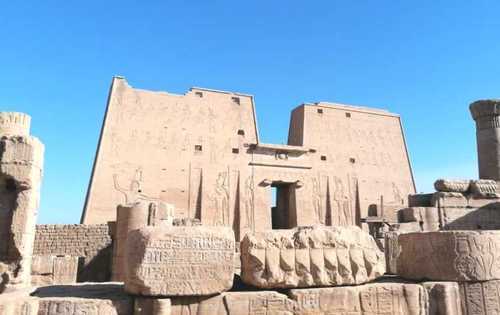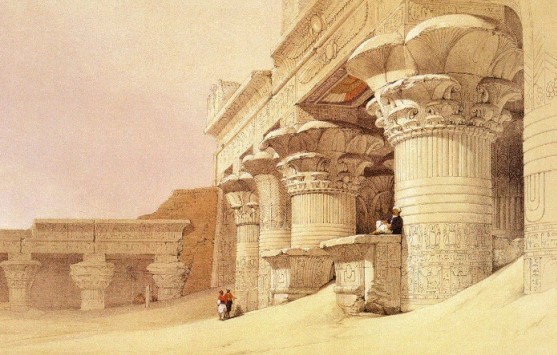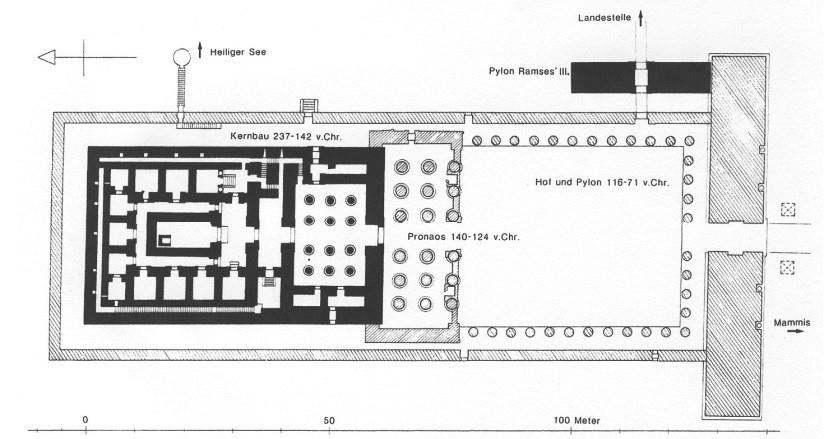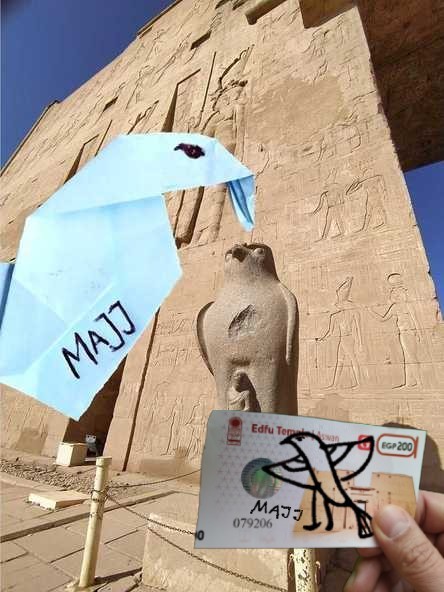The Horus Temple of Edfu - Nubian Sandstone /
Der Horus-Tempel von Edfu - Nubischer Sandstein
In advance: T=1.0 : The temple is officially wheelchair accessible & is also part of tours for wheelchair users.
And yes, it is possible....but we still recommend having support after our inspection.

Geology - Nubian Sandstone
Egypt is part of the African tectonic plate - the ancient continental shelf was formed in Precambrian times and underlies the entire African continent. Portions of this continental crust, locally referred to as the Nubian-Arabian Shield, lie exposed by uplift and erosion at the surface.
In course of the Mesozoic (Mesozoic 250 - 65 million years), the supercontinent Pangea drifted apart. The flooding of large parts of the African plate by the giant Tethys ocean then peaked during the Cretaceous period (135 - 65 million years).
Extensive sandstones were now deposited, which today are exposed mainly in southern Egypt and northern Sudan - an area known as Nubia - and which is therefore referred to as Nubian sandstone.
This soft sandstone, colored yellow to reddish-brown due to its iron oxide content, was often used in temples such as Edfu in Upper Egypt due to its easy workability. (2)
In Pharaonic Egypt, the use of sandstone can be proven from the Middle Kingdom. This rock type flanks the Nile valley south of the limestone areas from Esna deep into Nubia; in particular, however, a nearby geological fault zone near Gebel Silsila between Kom Ombo and Edfu - the Nile cuts through a double hill like a gorge here - represents an important place for sandstone extraction from Pharaonic to Roman times.
Sediments are generally referred to as sandstone, which consist mainly of 0.063-2.0mm large quartz or silicate grains. The degree of sorting of the grains can vary, but mostly it shows good uniformity and is very mature, i.e. it is quartz sandstone, with quartz being very dominant with almost 100%.
Sandstone originated from an originally loose sand, which in turn consists of a more or less densely packed structure of individual sand grains that touch each other tangentially. Only during the diagenesis, the solidification of the stone, the individual grains of sand baked together by pressure and cement. Binders can be various substances that penetrate between the individual grains over long periods of time - often hundreds of thousands of years - and form a more or less hard rock by growing on the sand particles or crystallizing out between them. These quartz, limonite, or calcium carbonate cements determine the color of the rock, which can range from dark reddish-brown to off-white. The light-colored stone, slightly colored by iron compounds, was preferred for temple construction. (1)
The entire temple complex of Edfu was largely covered with sand for many centuries and was excavated in the second half of the 19th century by Mariette, the director of the Service des Antiquités de l'Egypte and founder of the Egyptian Museum in Cairo.
Geologie - Nubischer Sandstein
Ägypten ist Teil der Afrikanischen Erdplatte – der uralte Festlandssockel wurde bereits in Präkambrischer Zeit gebildet und unterlagert den gesamten afrikanischen Kontinent. Teile dieser kontinentalen Kruste, die hier regional als Nubisch-Arabischer Schild bezeichnet wird, liegen – durch Hebung und Erosion freigelegt – an der Oberfläche.
Im Verlauf des Mesozoikum (Erdmittelalter 250 - 65 Mio. Jahre) driftete der Superkontinent Pangäa auseinander. Die Überflutung von weiten Teilen der Afrikanischen Platte durch den Riesenozean Tethys hatte dann während der Kreidezeit (135 - 65Mio. Jahre) ihren Höhepunkt.
Es wurden jetzt weitflächige Sandsteine abgelagert, die heute vor allem im Süden Ägyptens und im nördlichen Sudan – einem als Nubien bekanntes Gebiet – aufgeschlossen sind und der deshalb als Nubischer Sandstein bezeichnet wird.
Dieser weiche, durch seinen Eisenoxid-Anteil gelb bis rötlich-braun gefärbte Sandstein wurde in Oberägypten aufgrund seiner leichten Bearbeitbarkeit häufig in Tempelanlagen wie z.B. hier in Edfu verbaut. (2)
Im pharaonischen Ägypten lässt sich die Verwendung von Nubischem Sandstein ab dem Mittleren Reich nachweisen. Dieser Gesteinstyp flankiert das Niltal südlich der Kalksteingebiete ab Esna bis tief nach Nubien hinein; insbesondere aber eine nahe geologische Störungszone bei Gebel Silsila zwischen Kom Ombo und Edfu - der Nil durchschneidet hier schluchtartig einen Doppelhügel - stellt für die Sandsteinsteingewinnung von pharaonischer bis in die römische Zeit einen bedeutsamen Platz dar.
Als Sandstein werden grundsätzlich Sedimente bezeichnet, welche vorwiegend aus 0,063–2,0mm großen Quarz- oder Silikatkörnern bestehen. Der Sortierungsgrad der Körner kann durchaus unterschiedlich sein, meistens zeigt er aber eine gute Gleichmäßigkeit und ist sehr ausgereift, das heißt, es handelt sich um Quarzsandstein, wobei der Quarz sehr dominant mit fast 100% Anteil auftritt.
Sandstein ist aus einem ursprünglich lockeren Sand entstanden, der wiederum aus einer mehr oder weniger dicht gepackten Struktur von einzelnen Sandkörnern besteht, die sich gegenseitig tangential berühren. Erst bei der Diagenese, der Steinverfestigung, werden die einzelnen Sandkörner durch Druck und mit Zement verbacken. Bindemittel können verschiedene Stoffe sein, die in langen Zeiträumen - oft hunderttausende von Jahren - zwischen die einzelnen Körner eindringen und ein mehr oder weniger hartes Gestein durch ein Anwachsen an die Sandpartikel oder Auskristallisieren zwischen diesen bilden. Diese Zemente aus Quarz, Limonit oder Calciumkarbonat bestimmen die Farbe des Gesteins, die von dunklem rotbraun bis grauweiß reichen kann. Der helle, von Eisenverbindungen leicht gefärbte Stein wurde dabei beim Tempelbau bevorzugt. (1)
Die gesamte Tempelanlage von Edfu war über viele Jahrhunderte zu großen Teilen mit Sand und Nilschlamm bedeckt und wurde erst in der zweiten Hälfte des 19. Jahrhunderts von Mariette, dem damaligen Direktor des Service des Antiquités de l'Egypte und Gründer des Ägyptischen Museums in Kairo, ausgegraben.

David Roberts, Westseite Pronaos des Tempels von Edfu, Lithografie 1860
History of the Temple of Horus at Edfu
The Temple of Edfu was a site of important festivals in honor of the gods of the Horus cult in Ptolemaic times. In addition to the New Year festival, the wedding of Horus from Edfu (Hor-Behdeti) with Hathor from Dendara (Hut-Hor-Iunet) and the festival of the victory of Horus over Seth from the Osiris and Horus myths were celebrated here every year. The temple was built in the period from 237 to 57 BC..
It is 137 meters long in its north-south orientation and 70 meters wide at the pylon front. Originally, the temple complex with its outbuildings, i.e. the sacred area, was completely surrounded by a brick wall, which is still preserved today. (3)
Historisches zum Tempel des Horus von Edfu
Der Tempel von Edfu war in ptolemäischer Zeit ein Ort wichtiger Feste zu Ehren der Götter des Horuskults. Neben dem Neujahrsfest feierte man hier jedes Jahr die Hochzeit des Horus von Edfu (Hor-Behdeti) mit der Hathor von Dendara (Hut-Hor-Iunet) sowie das Fest des Sieges von Horus über Seth aus dem Osiris- und Horusmythos; er wurde im Zeitraum von 237 bis 57 v. Chr. erbaut.
Der Tempel ist in seiner Nord-Süd-Ausrichtung 137 Meter lang und an der Pylonenfront 70 Meter breit. Ursprünglich war die Tempelanlage mit ihren Nebengebäuden, also der heilige Bezirk, komplett von einer Ziegelmauer umgeben, die heute noch teilweise erhalten ist. (3)

Grundriss des Edfu Tempels (Quelle: Arnold, D., Die Tempel Ägyptens, Bechtermünz Verlag, Augsburg 1996, S.100).
The pylon is the actual entrance gate to the temple. If you walk through the pylon, you reach the large colonnaded courtyard. The pillars of the courtyard and the wall surfaces behind them are provided with reliefs, which mostly show sacrificial and cult acts of the pharaoh before the gods. From the vestibule (pronaos) you reach the large columned hall, the ceiling of which is also supported by twelve plant columns. Small slits of light on the walls ensure minimal natural lighting and allow the contours of the reliefs to stand out. On the sides, small passages lead to the temple ambulatory and a staircase to the temple roof. If you continue to follow the south-north axis, you reach the main sanctuary, the holy of holies, through two smaller wide-space vestibules.
Der Pylon ist das eigentliche Eingangstor zum Tempel. Durchschreitet man den Pylon, gelangt man in den großen Kolonnadenhof. Die Säulen des Hofes und die Wandflächen dahinter sind mit Reliefs versehen, die meist Opfer- und Kulthandlungen Pharaos vor den Göttern zeigen. Von der Vorhalle (Pronaos) gelangt man in den großen Säulensaal, dessen Decke ebenfalls von zwölf Pflanzensäulen getragen wird. Kleine Lichtschlitze an den Wänden sorgen für eine natürliche Minimalbeleuchtung und lassen die Konturen der Reliefs hervortreten. An den Seiten führen kleine Durchgänge zum Tempelumgang und eine Treppe zum Tempeldach. Folgt man weiter der Süd-Nord-Achse, gelangt man durch zwei kleinere Breitraum-Vorhallen zum Hauptsanktuar, dem Allerheiligsten.
In order to successfully log this Earthcache, please complete the following tasks (answers in English or German, please):

example for mandatory origami-bird / horus-picture-log
1. Describe exactly the Nubian sandstone (e.g. look, color, grit, structure...). You needn't touch it.
2. Estimate how high the temple was covered in sand before excavation (the upper Lithography of David Roberts may help...).
Guess how it came about.
Send the answers to Nr. 1 & 2 as a message.
3. Create a origami Falcon/Horus (see photos for instructions) or draw it on a paper (e.g. your entrance ticket), write your geocacher name on it and take a photo of your creation with the temple on site.
Attach the photo with your origami/drawing & the temple to your online log on the log page of this cache.
We don't need the photo in your message with the answers to task 1 and 2.
All 3 tasks are mandatory for a successful log.
Online Logs without a photo with your origami or drawing and without replies to task 1 &2 by message will be deleted within one week.
After sending the answers, you are welcome to log with your photo.
We'll let you know if something isn't right.
----------------------------------------------------------------------------------------------------------------------------
Um diesen Earthcache erfolgreich zu loggen, erfüllte bitte folgende Aufgaben:
1. Beschreibe möglichst genau den nubischen Sandstein (z.B. Aussehen, Farbe, Körnung, Strukur...). Du musst nichts anfassen.
2. Schätze wie hoch der Tempel vor der Ausgrabung mit Sand bedeckt war (Die Lithographie von David Roberts oben hilft vielleicht...). Vermute, wie es dazu kam.
Schicke uns die Antworten zu 1 und 2 als Nachricht.
3. Bastle einen Papier-"Horus"Vogel (Anleitung siehe Fotos) oder zeichne einen Horus-Vogel auf einem Papier (oder dem Eintrittsticket) ab, schreibe Deinen Geocacher-Namen darauf und mache vor Ort ein Foto von Deiner Bastelei/Zeichnung & dem Tempel.
Hänge das Foto an Dein Log.
Alle 3 Aufgaben sind verbindlich für ein erfolgreiches Log.
Logs ohne Antworten und ohne Foto mit Bastelei oder Zeichnung werden nach einer Woche gelöscht.
Nach Zusenden der Antworten darf gerne bereits mit Papier-Vogel-Foto geloggt werden.
Wir melden uns, wenn etwas nicht passt.
-----------------------
Quellenangaben:
1) Vgl. Bauer, Peter: Steine und Steinbrüche im alten Ägypten, Vortrag in der MGW, 2015,
https://www.mgw.or.at/private/arbeitsgebiete/interessantes/steinbruecheimaltenaegypten_2015.pdf (abgerufen am 07.01.2023)
2) Vgl. Dr. Braun, Sasha: Ägyptens geomorphologisches Gesicht – Einblicke in die Erdgeschichte, 2016,
http://papyrus-magazin.de/geschichte/aegyptens-geomorphologisches-gesicht-einblicke-in-die-erdgeschichte/ (abgerufen am 02.01.2023)
3) Vgl. https://de.wikipedia.org/wiki/Tempel_von_Edfu (abgerufen am 07.01.2023)